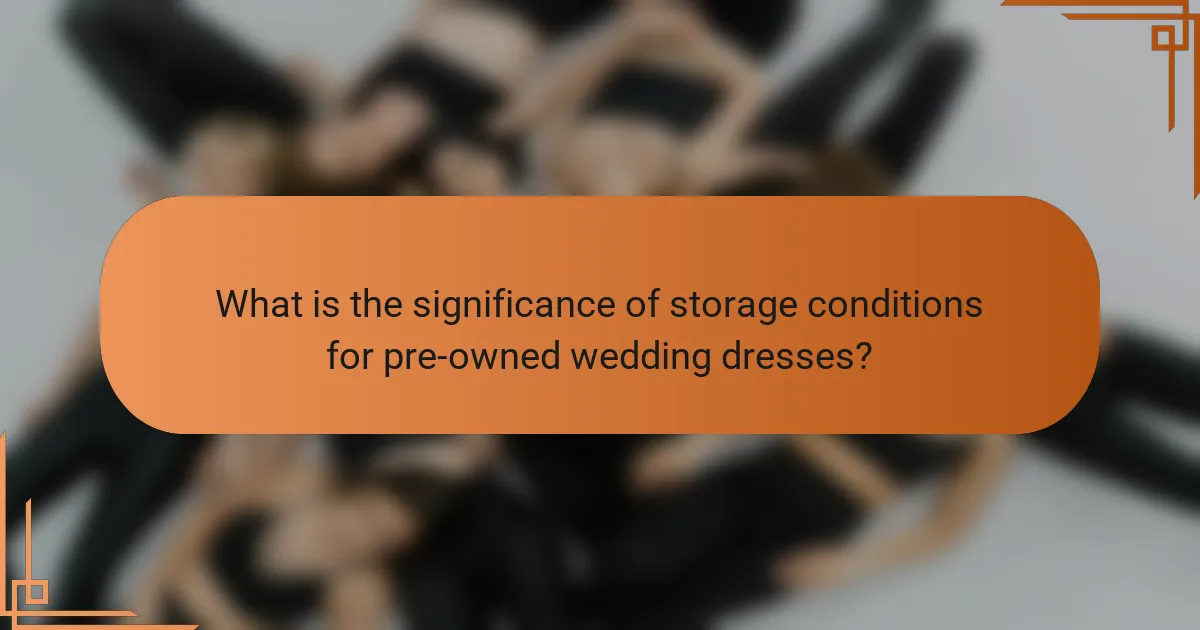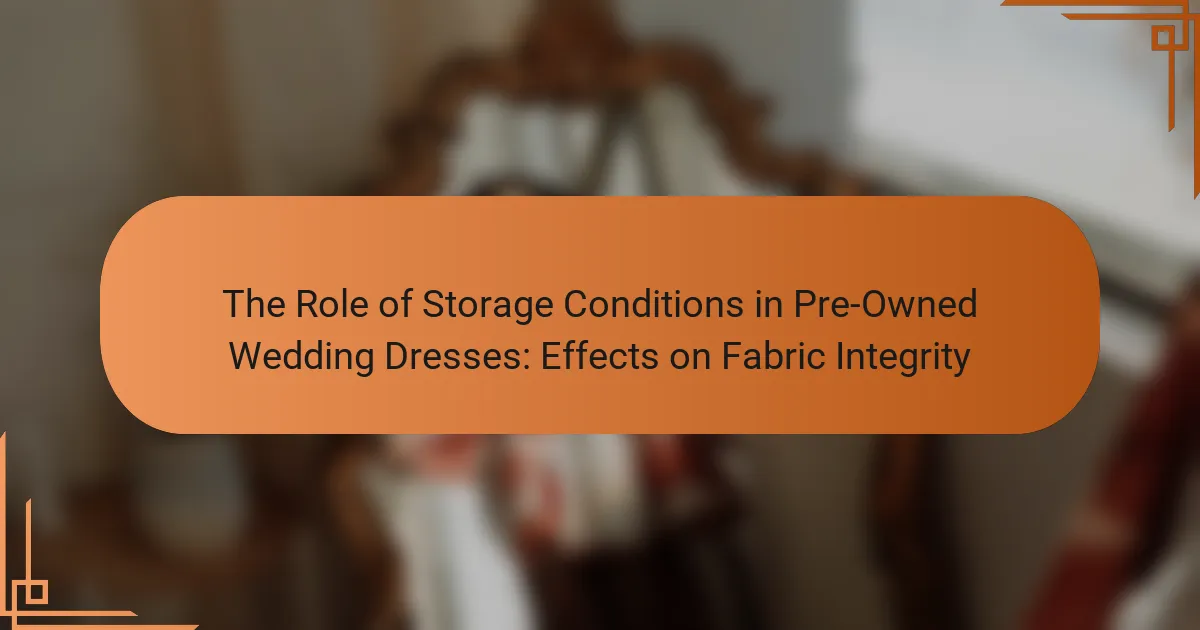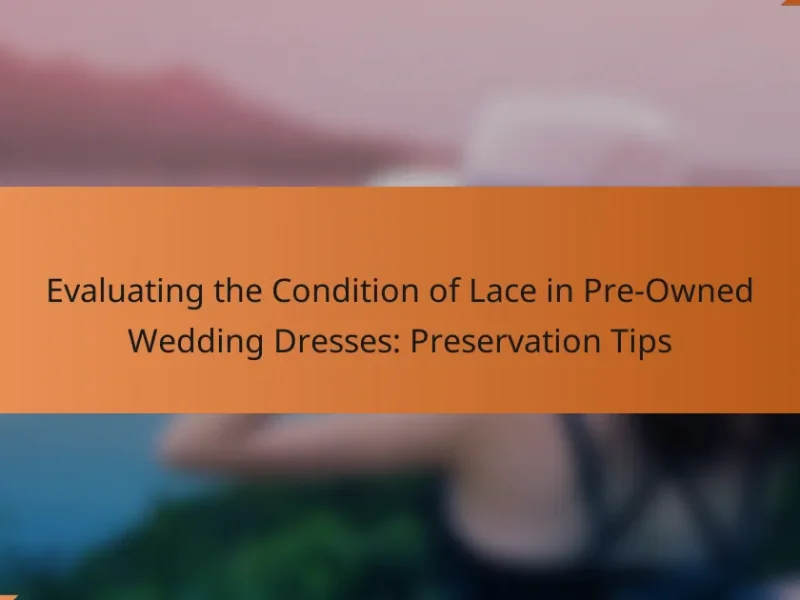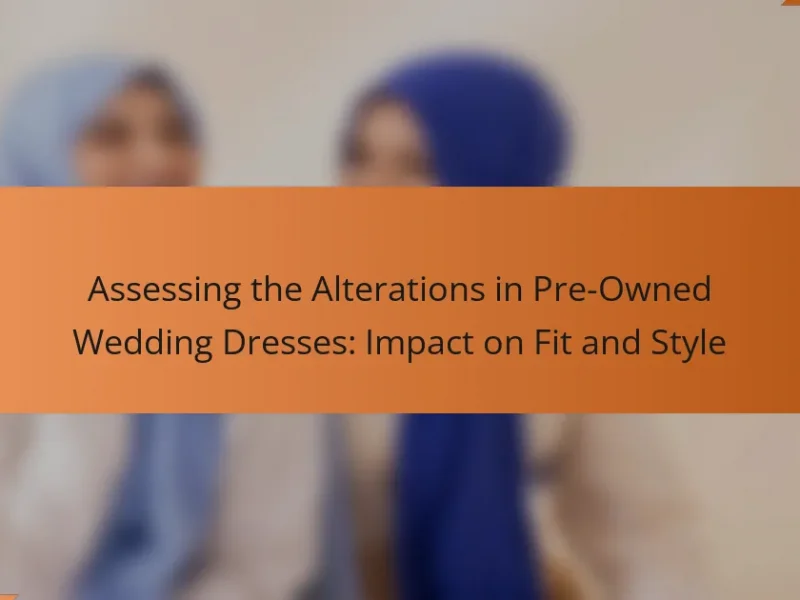Storage conditions significantly impact the integrity of pre-owned wedding dresses, which are sensitive to environmental factors. Maintaining appropriate humidity and temperature levels is essential to prevent mold, mildew, and fabric deterioration. Protecting dresses from direct sunlight is crucial to avoid fading, while breathable garment bags can shield them from dust and insects. The use of acid-free tissue paper is recommended to prevent yellowing caused by acidic materials. Ensuring a cool, dark, and dry storage environment extends the lifespan of these garments, enhancing their appeal for future use.

What is the significance of storage conditions for pre-owned wedding dresses?
Storage conditions are crucial for pre-owned wedding dresses to maintain their fabric integrity. Proper storage prevents deterioration caused by environmental factors. Humidity and temperature fluctuations can lead to mold and mildew growth. Direct sunlight exposure can cause fading and discoloration. Storing dresses in breathable garment bags protects them from dust and insects. Acidic materials can cause yellowing; thus, using acid-free tissue paper is advisable. Ensuring a cool, dark, and dry environment preserves the dress’s original condition. These practices extend the lifespan of the garment, making it more appealing for future use.
How do storage conditions affect the fabric integrity of wedding dresses?
Storage conditions significantly impact the fabric integrity of wedding dresses. Factors such as light exposure, humidity, and temperature can cause deterioration. Prolonged exposure to direct sunlight can lead to fading and weakening of fibers. High humidity levels can encourage mold growth, damaging delicate fabrics. Conversely, very low humidity can cause fabrics to become brittle and prone to tearing. Additionally, improper folding or hanging can result in creases or distortions in the fabric structure. Research indicates that maintaining a cool, dry, and dark environment preserves the quality of wedding dresses. Proper storage techniques, such as using acid-free tissue and breathable garment bags, further protect the fabric’s integrity.
What types of fabrics are commonly used in wedding dresses?
Common fabrics used in wedding dresses include satin, lace, tulle, chiffon, and organza. Satin is known for its smooth surface and luxurious feel. Lace adds intricate designs and textures, often used for overlays. Tulle is lightweight and airy, providing volume to the dress. Chiffon is soft and flowy, ideal for creating elegant silhouettes. Organza is crisp and sheer, often used for layering. These fabrics are chosen for their aesthetic appeal and suitability for various wedding styles.
How does fabric type influence the effects of storage conditions?
Fabric type significantly influences how storage conditions affect the integrity of pre-owned wedding dresses. Different fabrics respond uniquely to environmental factors like humidity, temperature, and light exposure. For example, silk is sensitive to moisture and can develop mildew if stored in humid conditions. Cotton, on the other hand, is more durable but can still suffer from discoloration if exposed to light. Synthetic fabrics like polyester are generally more resistant to environmental damage but can be affected by high temperatures during storage. The specific weave and finish of each fabric type also play a role in its susceptibility to damage. Understanding these differences is crucial for preserving the quality of wedding dresses during storage. Proper care guidelines based on fabric type can help maintain the dress’s appearance and longevity.
Why is it important to preserve the integrity of pre-owned wedding dresses?
Preserving the integrity of pre-owned wedding dresses is crucial for maintaining their aesthetic and structural quality. Proper preservation prevents fabric deterioration and damage over time. Wedding dresses often feature delicate materials that can be easily compromised by environmental factors. Factors such as humidity, light exposure, and temperature fluctuations can lead to yellowing, fading, or fabric weakening. Furthermore, a well-preserved dress retains its resale value, making it more appealing for future buyers. According to the National Cleaners Association, improper storage can lead to irreversible damage, emphasizing the need for careful handling and preservation methods.
What are the potential consequences of poor storage on wedding dresses?
Poor storage can lead to significant damage to wedding dresses. This damage may include yellowing of fabrics due to improper exposure to light and air. Mold and mildew can develop if dresses are stored in humid conditions. Creasing and permanent wrinkles can occur from inadequate hanging or folding techniques. Additionally, delicate embellishments may become loose or fall off due to pressure from improper storage. Discoloration can result from contact with certain materials, such as plastic. These issues can severely affect the dress’s aesthetic and structural integrity. Proper storage is essential to preserve the dress for future use or display.
How can fabric integrity impact the dress’s resale value?
Fabric integrity significantly impacts a dress’s resale value. High-quality fabric in excellent condition maintains its visual appeal and durability. Buyers prioritize dresses with intact fabric, as they indicate better overall care. Damaged or worn fabric can lead to lower perceived value. For instance, a dress with stains or tears may sell for 30% less than one in pristine condition. Additionally, reputable brands often retain higher resale values when fabric integrity is preserved. In summary, fabric integrity directly correlates with resale value due to buyer preferences and perceived quality.
What are the best practices for storing pre-owned wedding dresses?
Store pre-owned wedding dresses in a cool, dry place to preserve fabric integrity. Use acid-free tissue paper to stuff the bodice and sleeves. This prevents creasing and maintains shape. Place the dress in a breathable cotton garment bag. Avoid plastic, as it can trap moisture and cause mildew. Store the dress flat if possible, or hang it with padded hangers. Regularly check for any signs of damage or discoloration. Keep the dress away from direct sunlight to prevent fading. These practices help maintain the dress’s quality over time.
How should different types of fabrics be stored to maintain integrity?
Different types of fabrics should be stored according to their specific needs to maintain integrity. Natural fibers like cotton and linen should be stored in a cool, dry place to prevent mildew. Synthetic fabrics such as polyester should also be kept in a dry environment but can tolerate slightly higher temperatures. Delicate fabrics like silk require acid-free tissue paper for cushioning and should be stored flat to avoid creasing. Wool should be stored in breathable bags to prevent moth damage. Heavy fabrics like denim can be folded but should not be compressed to avoid distortion. Proper storage conditions prevent degradation and extend the lifespan of the fabric.
What environmental factors should be considered in storage?
Temperature, humidity, light exposure, and air quality are key environmental factors in storage. Temperature should be stable, ideally between 60-70°F, to prevent fabric damage. High humidity levels can lead to mold growth, while low humidity can cause fabrics to become brittle. Light exposure, particularly UV light, can fade colors and weaken fibers. Air quality is crucial; pollutants can degrade fabric integrity over time. Proper storage conditions can significantly extend the lifespan of pre-owned wedding dresses.
How can improper storage conditions be identified?
Improper storage conditions can be identified through several key indicators. First, signs of discoloration on fabrics suggest exposure to light or humidity. Second, the presence of mold or mildew indicates excessive moisture levels. Third, fabric stiffness or brittleness often results from inadequate air circulation. Fourth, unpleasant odors can signal chemical reactions or decay. Additionally, visible wrinkling may indicate improper folding or storage methods. Lastly, insect damage, such as holes or fraying, points to inadequate pest control measures. These indicators can help assess the suitability of storage conditions for preserving the integrity of pre-owned wedding dresses.
What signs indicate fabric damage in stored wedding dresses?
Signs that indicate fabric damage in stored wedding dresses include discoloration, fraying, and stains. Discoloration can manifest as yellowing or fading of the fabric. This often occurs due to exposure to light or improper storage conditions. Fraying edges are a sign of wear and can indicate that the fabric is deteriorating. Stains may result from spills or contact with contaminants such as dust or moisture. Additionally, a musty odor can suggest mold growth, which damages fabric integrity. Inspecting for these signs regularly can help preserve the dress’s condition.
How can one assess the overall condition of a pre-owned wedding dress?
To assess the overall condition of a pre-owned wedding dress, examine the fabric for stains, tears, or discoloration. Check the seams and hems for fraying or loose threads. Inspect the lining for wear and any signs of damage. Review the dress’s structure, ensuring it retains its original shape and support. Look for any alterations that may affect fit or appearance. Pay attention to the presence of odors, which may indicate improper storage. Finally, consider the dress’s age and previous storage conditions, as these factors significantly impact fabric integrity.
What tips can help maintain the fabric integrity of pre-owned wedding dresses?
Store pre-owned wedding dresses in a cool, dry place. Avoid exposure to direct sunlight, as it can fade the fabric. Use acid-free tissue paper to help maintain shape and prevent creasing. Keep the dress in a breathable garment bag, not plastic, to allow air circulation. Regularly check for any signs of mold or mildew in storage. Avoid hanging the dress for long periods to prevent stretching. Clean the dress according to the fabric care label before storing it. These practices help preserve the fabric integrity over time.
The main entity of this article is pre-owned wedding dresses, specifically focusing on the significance of storage conditions for their fabric integrity. The article outlines how various environmental factors, such as humidity, temperature, and light exposure, can lead to deterioration of wedding dress fabrics, including common materials like satin, lace, and chiffon. It emphasizes best practices for storage, such as using breathable garment bags and acid-free tissue paper, to prevent damage and maintain the dress’s aesthetic and structural quality. Additionally, the article discusses the impact of fabric integrity on the resale value of wedding dresses and provides tips for assessing and maintaining the condition of stored dresses.


